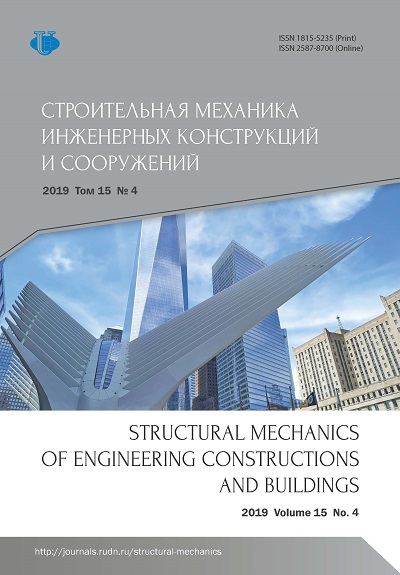Criteria of strength of walls from large masonry blocks
- Authors: Pyatikrestovsky K.P.1
-
Affiliations:
- Research Center of Construction (Joint Stock Company)
- Issue: Vol 15, No 4 (2019)
- Pages: 271-277
- Section: Analysis and design of building structures
- URL: https://journals.rudn.ru/structural-mechanics/article/view/21804
- DOI: https://doi.org/10.22363/1815-5235-2019-15-4-271-277
Cite item
Full Text
Abstract
Aims of research. The task is to apply modern strength criteria of anisotropic materials for the calculation of multilayer walls made of cellular concrete and silicate large masonry materials, which differ in exact dimensions and allow for thin-seam masonry with adhesive seams. Proposals for the inclusion in the design standards of guidance that takes into account the work of wall materials in complex stress states will be presented in a series of publications. Methods. The strength criteria of G.A. Geniev in a rather simplified form are used. The volumetric stress state of walls made of orthotropic materials is considered. The basis for the construction of strength criteria are three possible different mechanisms of destruction - separation, compression and shear. For modern thin-walled masonry is characterized by a combination of compressive (vertical) and shear (horizontal) loads. Of particular interest is the work of the masonry shift, since the plane stress state is not sufficiently studied. The article is devoted to the construction of the criterion of masonry shear strength. The peculiarity of the proposed calculations is the comparative simplicity of the strength criteria due to the accepted hypotheses. Results. The final expression of the shear strength criterion and the sequence of the shear strength verification in the case of simple loading are presented. The article is preliminary for a series of calculations and results of experimental studies of the walls under different operating conditions and different loads.
About the authors
Konstantin P. Pyatikrestovsky
Research Center of Construction (Joint Stock Company)
Author for correspondence.
Email: stroymex@list.ru
SPIN-code: 7983-5656
Doctor of Science (Technical), chief researcher, Research Institute of Building Constructions (TSNIISK) named after V.A. Koucherenko;
6 2-ya Institutskaya St., Moscow, 109428, Russian FederationReferences
- Gol'denblat I.I., Kopnov V.A. (1968). Kriterii prochnosti i plastichnosti konstrukcionnyh materialov [Criteria of strength and plasticity of structural materials]. Moscow, Mashinostroenie Publ., 190. (In Russ.)
- Pisarenko G.S., Lebedev A.A. (1976). Deformirovanie i prochnost' materialov pri slozhnom napryazhennom sostoyanii [Deformation and strength of materials under complex stress conditions]. Kyiv: Naukova dumka Publ., 412. (In Russ.)
- Ashkenazi E.K., Morozov A.S. (1976). Metodika ehksperimental'nogo issledovaniya uprugih svojstv kompozicionnyh materialov [Methods of experimental study of elastic properties of composite materials]. Zavodskaya laboratoriya [Plant laboratory], (6), 731–735. (In Russ.)
- Ashkenazi E.K., Ganov Eh.V. (1980). Anizotropiya konstrukcionnyh materialov: spravochnik [Anisotropy of structural materials: handbook]. Leningrad: Mashinostroenie Publ., Len. otd., 247. (In Russ.)
- Belyaev N.M. (1957). Trudy po teorii uprugosti i plastichnosti [Works on the theory of elasticity and plasticity], Moscow, Gos. izd-vo tekhniko-teoreticheskoj literatury Publ., 632. (In Russ.)
- Geniev G.A., Kurbatov A.S. (1991). O predel’nom soprotivlenii anizotropnyh materialov sdvigu pri trekhosnom napryazhyonnom sostoyanii [On the limit resistance of anisotropic materials to shear at a triaxial stress state]. Stroitel’naya mekhanika i raschet sooruzhenij, (3), 3–7. (In Russ.)
- Geniev G.A., Kurbatov A.S. (1990). O predel’nyh prochnostnyh zavisimostyah dlya anizotropnyh materialov pri sdvige [On limit strength dependences for anisotropic materials during shear]. Metody rascheta i optimizacii stroitel’nyh konstrukcij na EHVM, 60–67. (In Russ.)
- Voronov A.N. (1985). Staticheskie ploskie zadachi deformacionnoj teorii plastichnosti ortotropnyh tel [Static plane problems of deformation theory of plasticity of orthotropic bodies]. (PhD dissertation, Moscow). 138. (In Russ.)
- Geniev G.A., Kurbatov A.S., Samedov F.A. (1993). Voprosy prochnosti i plastichnosti anizotropnyh materialov [Questions of strength and plasticity of anisotropic materials]. Moscow, Interbuk Publ., 187. (In Russ.)
- Karpenko V.M. (1996). Obshchie modeli mekhaniki zhelezobetona: monografiya [General models of reinforced concrete mechanics: monograph]. Moscow, Strojizdat Publ. (In Russ.)
- Bondarenko V.M., Kolchunov V.I. (2004). Raschetnye modeli silovogo soprotivleniya zhelezobetona: monografiya [Computational model of a power resistance of reinforced concrete: monograph]. Moscow, ASV Publ., 472. (In Russ.)
- Kabancev O.V. (2013). Deformacionnye svojstva kamennoj kladki kak raznomodul'noj kusochno-odnorodnoj sredy [Deformation properties of masonry as a multi-modular piecewise homogeneous medium]. Sejsmostojkoe stroitel’stvo. Bezopasnost’ sooruzhenij, (4), 36–40. (In Russ.)
- Kabancev O.V. (2016). Kriterii predel’nyh sostoyanij kamennyh konstrukcij sejsmostojkih zdanij [Criteria of limit states of stone structures of earthquake-resistant buildings]. Sejsmostojkoe stroitel’stvo. Bezopasnost’ sooruzhenij, (2), 29–39. (In Russ.)
- Page A.W. (1981, Sept.). The biaxial compressive strength of brick masonry. Proc. Inst. Civ. Eng. Part 2, 71, 893–906.
- Ponomarev O.I., Pyatikrestovskij K.P., Muhin M.A. (2019). Raschet novyh kamennyh konstrukcij v ploskom napryazhennom sostoyanii [The calculation of new masonry structures under plane stress]. Vestnik NIC “Stroitel’stvo”, 2(21), 136–146. (In Russ.)
- Pyatikrestovskij K.P., Muhin M.A. (2019). Primenenie sovremennyh kriteriev prochnosti pri razrabotke novyh stenovyh tonkoshovnyh kleevyh kamennyh kladok [Application of modern strength criteria in the development of new wall thin-seam adhesive masonry]. Fundamental’nye, poiskovye i prikladnye issledovaniya RAASN i nauchnoe obespechenie razvitiya arhitektury, gradostroitel'stva i stroitel’noj otrasli Rossijskoj Federacii, 236–261. (In Russ.)
















